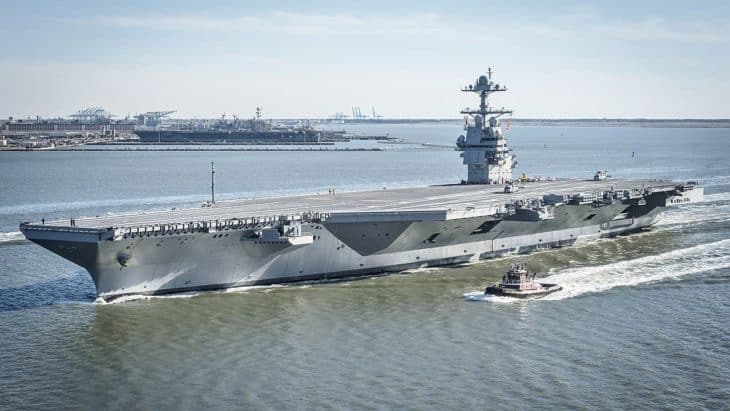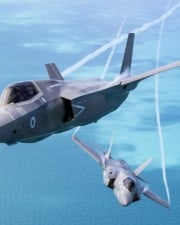Where caravels ruled the Age of Exploration, Man-of-Wars and Ships of the Line ruled the seas in the eighteenth and early nineteenth century, and battleships dominated the waves at the outbreak of World War I, today aircraft carriers are the top dog at sea. But just how fast can an aircraft carrier go?
How Fast Can an Aircraft Carrier Travel?
There is a lot of complexity to this question, and the result is more of a ballpark estimate than an exact radar gun figure. That said, top of the line ships such as Nimitz-class aircraft carriers are able to reach top speeds in excess of 30 knots.
What does “in excess” mean exactly?
Modern Aircraft Carrier Speeds
As stated, this is a difficult question to answer, partially because it varies depending on how one considers aircraft carrier speed, and partly because it isn’t as though navies are in the business of broadcasting their top speeds or racing their ships against one another.
What’s more, unlike cars or planes, ships are not typically time tested in the same way. While they can be put through their paces, like top of the line ships undergoing trials such as the USS John F. Kennedy and HMS Prince of Wales are, exact speed tests are rare.
Hence the nautical term “in excess.” While navies do not always know (or publish) the potential top speed of their aircraft carriers, they do tell us a baseline speed
That speed tends to be around 30 knots. The USS Gerald R. Ford can travel in excess of that speed. Its closest foreign rival, the HMS Queen Elizabeth, is right on its tail, being able to cruise at speeds in excess of 29 knots.

Even that estimation has its problems, however. For one thing, by some estimates, the former ship can crank it up to 35 knots. For another, even that 35 knots may seem low to some due to the fact that previous ships have been able to reach comparable speeds.
For example, while it can’t reach Warp 9 like its sci-fi namesake, the USS Enterprise, an aircraft carrier retired in 2017, could reportedly reach a top speed of somewhere in excess of 33 knots.
The USS Gerald R. Ford is the largest and most expensive aircraft carrier of all-time.
It wouldn’t make sense for its “in excess” speed of 30 knots (albeit with a top speed of 35 knots) to trail or be comparable to a craft which was retired two years ago.
Older Types of Aircraft Carriers
With that in mind and the USS Gerald R. Ford, HMS Queen Elizabeth, and USS Enterprise already accounted for, let’s take a look at the speed and history of some of the other top aircraft carriers out there.
Right off the bat we see why trying to “clock” the speed of an aircraft carrier is a difficult endeavor.
The USS Wisconsin was an aircraft carrier that operated during World War II, engaging in the Pacific Theater. It was decommissioned and modernized several times before finally being taken out of active service for good in 1991. With six battle stars to her name, she was a great ship.
How Fast Is A WW2 Aircraft Carrier
The USS Wisconsin was reported to have a top sustained speed of 30 knots and could reach 33 knots.
Chances are an aircraft carrier from World War II (or, if we’re to assign those speeds to its last military engagement, service during Operation Desert Storm) isn’t going to outpace the Royal Navy’s top ship today and push the US Navy’s big gun out there, either.
That may ultimately tell us more about the HMS Queen Elizabeth and USS Gerald R. Ford – namely, that “in excess of 30 knots” is a way of giving an impressive-sounding estimate without giving exact details of current top speed capabilities.
How Fast Are Russia, China, Brazil Aircraft Carriers
Let’s talk about a few other points of comparison. Russia’s Admiral Kuznetsov, China’s Liaoning, and Brazil’s Sao Paulo are all the top dogs of their respective fleets.
They are vastly different in terms of size and history. Russia’s ship is a holdover from its USSR days with a storied sea history, while China’s ship is far newer, and Brazil’s was retired the same year as the USS Enterprise, 2017.
Despite their different eras of construction as well as their wildly differing military histories, however, all three are listed with a top speed of 32 knots.

While it’s certainly possible that a decades-old Soviet vessel might have been able to outpace the USS Wisconsin at some point, chances are it isn’t going to win a race against the USS Gerald R. Ford or HMS Queen Elizabeth.
And yet those ships are listed with top speeds of “29 knots” and “in excess” of 30 knots.
In fairness, those are top speeds. Russia and China’s two ships are given a “sustained” speed of 29 knots, while Brazil’s now-decommissioned ship could reach 18 knots. Even so, that would still put those two older vessels in line with the top two aircraft carriers in the world.
As such, while “in excess of 30 knots” seems to be the benchmark for “fast” aircraft carriers, their exact top or sustained speeds seem understandably elusive.
References ▾
Related Posts














